Glossary
Trademarks HTL's policy regarding the use of trademarks is described here.
active noise cancellation (abbreviated ANC) – the use of microphones and feedback and/or feedforward techniques to suppress external noise by the addition of an antiphase signal which cancels it; in headphones, ANC is most effective at frequencies below about 1kHz, which makes it particularly useful for suppressing common intrusive environmental sounds (aircraft cabin noise, car cabin noise, etc.) as these are dominated by low-frequency content; a side-effect of ANC is that it often alters headphone frequency response
air motion transformer (abbreviated AMT) – a form of electromagnetic drive unit, invented by Dr Oskar Heil, in which the diaphragm is pleated and motion occurs in the plane of the diaphragm, sound being generated by air being alternately expelled from and drawn into the pleats, which open and close rather like bellows; claimed advantages of the AMT are superior transient response and low nonlinear distortion; although AMT tweeters have become increasingly popular in loudspeakers in recent years, the use of AMT drivers in headphones is still rare, despite full-range operation being achievable
AAC (abbreviation for Advanced Audio Coding) – a proprietary lossy audio codec, using perceptual coding techniques, designed by a consortium of contributing companies as a successor to MP3 and the default codec for Apple’s iTunes, which is supported by some Bluetooth devices including wireless headphones; providing generally superior sound quality to MP3, AAC is particularly effective at low bit rates (below 128kb/s)
aluminium – one of the lowest-density metallic elements which also has good physical properties, as a result of which it is widely used in headphone construction, and as a diaphragm material in loudspeakers and, less frequently, headphones too; as a constructional material it is bettered by magnesium, which has even lower density but is more costly; as a diaphragm material it performs similarly to magnesium and titanium, both of which have similar ratios of tensile modulus to density and hence similar velocities of sound (approximately 5km/s), as shown in the table below
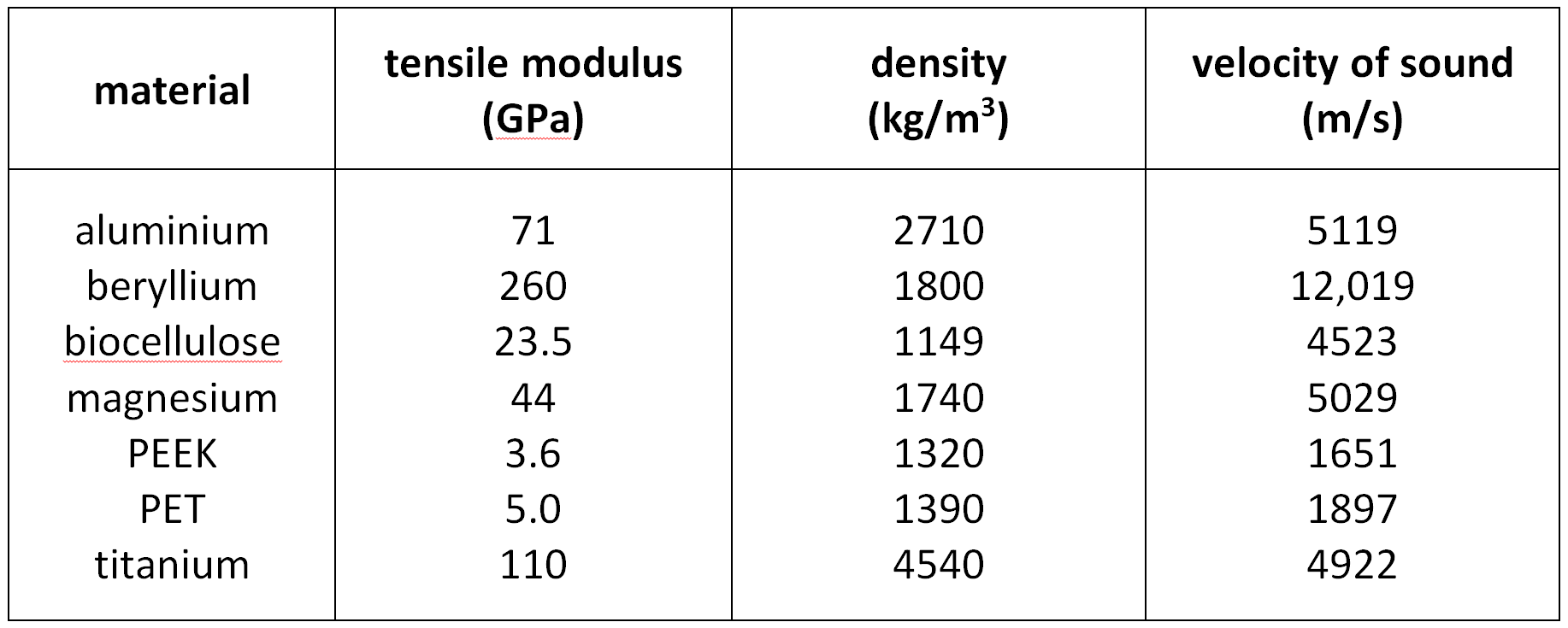
Physical properties of various diaphragm materials
aptX – a range of proprietary lossy audio codecs, widely used in headphone Bluetooth interfaces, developed by Qualcomm Incorporated of California, all of which use adaptive differential PCM (ADPCM) techniques for data reduction rather than perceptual coding (‘apt’ stands for audio processing technology); the aptX range currently comprises four codecs: the original aptX which operates at a maximum 384kb/s, aptX LL (low latency) which operates at 352kb/s, aptX HD (high definition) which operates at 576kb/s, and aptX Adaptive which operates at either 276 or 420kb/s
balanced – a three-conductor signal interface in which two conductors carry signal voltage in antiphase and the third is connected to earth (ground); balanced connection is more complex but provides greater immunity from external electromagnetic interference than the unbalanced alternative; conventionally headphones have used unbalanced connection but in recent years balanced connection has been offered as an alternative by some headphone amplifiers, for compatible headphones; balanced stereo headphone connections are usually made using two 3-pin XLRs, a single 4-pin XLR or a Pentaconn jack connector
balanced armature – a type of compact electromagnetic drive unit, originally developed for hearing aids and now widely used in insert headphones; in hybrid headphones, which use a combination of moving coil and balanced armature drivers, the moving coil unit usually reproduces low frequencies and the balanced armature unit high frequencies; balanced armature drivers are sufficiently compact that many advanced IEMs use multiple drivers covering different frequency ranges
beryllium – the metallic element with the highest ratio of tensile modulus to density, which results in it having the highest velocity of sound of any metal at approximately 12km/s, more than double that offered by aluminium, magnesium or titanium (the other metals commonly used for loudspeaker diaphragms, and sometimes headphone diaphragms – see the table attached to the ‘aluminium’ entry); high velocity of sound is an advantage because it raises the frequency of diaphragm breakup resonances
biocellulose (aka bacterial or microbial cellulose) – a form of bio-engineered cellulose first used as a headphone diaphragm material by Sony Corporation; rather than being extracted from plant material, biocellulose is synthesized by bacteria of the genus Acetobacter, particularly Gluconacetobacter xylinus; biocellulose fibres are much thinner than those extracted from plant material (diameter about two orders of magnitude less than the ~10µm diameter of wood pulp) and have been shown to be capable of, with chemical after-treatment, a tensile modulus of over 20GPa and velocity of sound exceeding 4.5km/s; although metals provide superior sound velocity, biocellulose has much higher internal damping (loss factor) which helps suppress diaphragm resonances
blocked meatus – a form of headphone measurement in which the measurement microphone of the artificial ear is placed at the outer end of what would be the ear canal in a real ear; blocked meatus measurements (taken at what is termed the EEP – ear canal entrance point) elicit different frequency responses to those taken at the DRP (drum reference point) in an artificial ear incorporating an ear simulator but standard corrections can be used to convert between the two; blocked meatus frequency response measurements typically demonstrate lower variability than DRM equivalents, but the blocked meatus technique is not is not suitable for measuring insert or intra-concha headphones
Bluetooth – a wireless interface technology, developed by the Bluetooth Special Interest Group, which is widely used to stream audio to headphones from smartphones and other sources; Bluetooth, the latest version of which is 5.2, supports a variety of lossy audio codecs including the default SBC (Sub-Band Coding), Qualcommm’s aptX family and Sony’s LDAC; a new addition to the standard is LE Audio, using the Low Complexity Communication Codec (LC3), which reduces power consumption and so extends battery life in portable applications
bone conduction – the auditory pathway through the ear canal and middle ear is not the only route whereby vibrations can reach the cochlear (the organ of hearing) in the inner ear: they can also reach it via bone conduction; headphones which exploit the bone conduction pathway generally achieve much lower sound quality than conventional headphones, finding principal use in exceptionally noisy environments such as military applications; what role bone conduction plays in conventional headphone listening has not been widely investigated
breakup – a somewhat dramatic term for mechanical resonances in the diaphragm of a loudspeaker or headphone; these don’t actually indicate or threaten physical damage, but the resonances may harm sound quality
capsule – also referred to as a ‘cup’, the part of a headphone which houses the drive unit(s) and delivers sound to the ears
CCAW (abbreviation of copper coated aluminium wire) – while copper is the traditional material for the voice coils of moving coil drive units, some opt instead for aluminium wire coated in a thin layer of copper as this reduces moving mass
circumaural – a headphone in which the earpads are intended to seal to the head around the ears rather than against them as in supra-aural designs; in reality, many ‘circumaural’ headphones have earpad openings which are too small to accommodate larger ears, which are physically distorted as a result; commonly, the earlobe is sandwiched between earpad and head
closed-back – a headphone in which sound emitted from the rear of the diaphragm (away from the listener) is contained within the headphone cup; because the enclosed space at the back of the diaphragm results in reflection and resonance, closed-back headphones are often considered inferior to open-back designs in respect of sound quality but have the twin advantages of causing minimal noise disturbance to people nearby, and of providing the user with isolation from external sounds, particularly at upper-midrange and treble frequencies
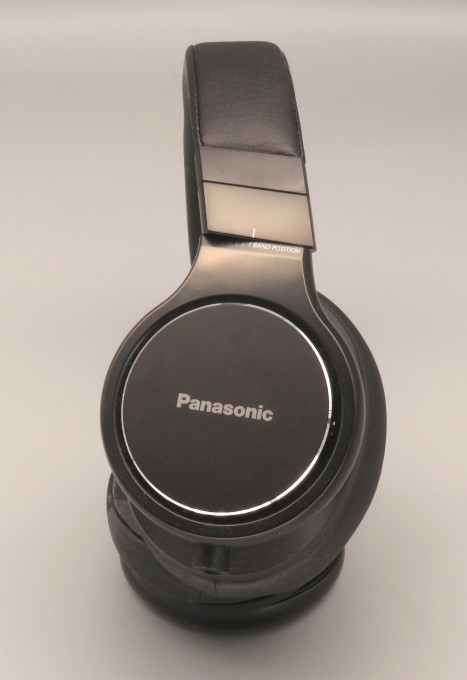
A closed-back headphone (Panasonic RP-HD10)
codec – a condensation of ‘coder-decoder’ which in digital audio refers particularly to signal processors which use data compression techniques to reduce the file size or bit rate necessary to store or stream an audio signal; ‘lossy’ codecs (eg. MP3) achieve the highest compression ratios, sometimes using perceptual coding algorithms, but the decoded signal is generally not be a bit-perfect reconstruction of the original; lossless codecs (eg. FLAC) achieve lower levels of compression – typically around 2:1 – but the decoded output signal is always an exact reconstruction of the input
compliance – the reciprocal (inverse) of stiffness, ie. high compliance equals low stiffness
concha – the large concave part of the external ear (pinna) which joins to the ear canal
corrected response – in headphones, a measured frequency response that has been adjusted to make it more representative, notionally, of the frequency response that will be perceived by the listener; historically, free-field and, later, diffuse-field corrections were favoured but more recently research by Harman International has defined target responses (and hence corrections) which differ from the diffuse-field assumption, particularly at low frequencies; where corrections are applied they should be defined, but commonly are not
CSD (abbreviation of cumulative spectral decay) – originally developed in the 1940s by D E L Shorter of the BBC, cumulative spectral decay is the oldest method of visualising resonances within the output of a loudspeaker or headphone; it comprises a pseudo-three-dimensional graph with frequency, amplitude and time axes, in which a succession of frequency response traces is overlaid, each derived from successive time steps through the device's impulse response; the ideal CSD result shows rapid decay in output at all frequencies, but more normally there are ridges present where the decay is lengthened due to resonance; see the ‘waterfall’ entry for an example
cup – an alternative term for ‘capsule’
decibel (abbreviated dB) – the logarithmic ratio of two quantities equivalent to
where V and Vr are voltages, the latter being the reference, or to
where P and Pr are powers; letters immediately following ‘dB’ indicate standard reference values, eg. dBV (reference 1V) or dBu (reference 1 milliwatt into 600 ohms); letters following ‘dB’ in brackets indicate standard frequency weightings, eg. dB(A) (A-weighted according to IEC 61672:2003)
diaphragm – the moving surface within a headphone or loudspeaker drive unit which radiates sound
diffuse-field – a headphone target frequency response, or related response correction, which corresponds to the frequency response at the human ear within a diffuse sound field (where sound arrives with equal intensity from all directions); the diffuse-field response was identified as the ideal headphone target response by research conducted by Günther Theile at IRT in Munich in the early 1980s
drive unit (or driver) – a transducer (energy converter) which converts electrical signals into sound as part of a loudspeaker or headphone; moving coil drive units are the most commonly used in headphones, although planar magnetic drivers have enjoyed a renaissance in recent years; headphones with electrostatic drive units remain rare
DRP (abbreviation of drum reference point) – the point at the centre of the inner end of the ear canal, where the eardrum is located
dynamic – a headphone which uses moving coil drive units
ear canal – the short (~25mm long) tubular structure which acoustically connects the concha of the human ear at its outer end, to the eardrum at its inner end
ear simulator – the component of an artificial ear which mimics the acoustical impedance of a real human ear, and which contains the microphone used to perform headphone frequency response measurements
EEP (abbreviation of ear canal entrance point) – the point at the centre of the ear canal opening
EQ (abbreviation for equalisation) – application of electronic frequency response correction
ERP (abbreviation of ear reference point) – a geometrical reference point located at the entrance to the external ear
electrostatic – a form of drive unit which exploits electrostatic forces to move the diaphragm and radiate sound, in contrast to the electromagnetic forces used in moving coil and planar magnetic drivers; the ultimate constant-charge, push-pull electrostatic driver (which generates the lowest nonlinear distortion) comprises a pair of perforated, electrically conductive plates disposed either side of a thin plastic diaphragm which is charged to a high polarising voltage via a high-value resistance which prevents charge migration from the diaphragm as it moves; signal voltage is applied to the two static plates (stators) in antiphase so as to provide push-pull operation; single-sided electrostatic drivers which lack this feature have higher distortion as a result; traditionally the high signal voltages required at the plates have been achieved using a step-up transformer but, particularly with electrostatic headphones, high-voltage valve (tube) or solid-state amplifier circuits can be used instead
external auditory meatus – the anatomical name for the ear canal
free-field – a headphone target frequency response, or related response correction, which corresponds to the frequency response at the human ear when a sound source is placed as a loudspeaker conventionally is for stereo listening, 30 degrees off the head’s median plane; although this may seem an obvious target response for headphones, it was largely superseded in the 1980s by the diffuse-field target response
headband – the curved structure which joins the left and right capsules of an over-head headphone and (usually) acts as spring to press their earpads against the head; ideally a headband should be vibrationally inert so as not to colour or blur sound quality, but not all achieve this
Hz (abbreviation of hertz) – the SI unit of frequency, equivalent to one cycle per second; as with all SI units, it is scaled in steps of 103 (1000) by means of prefixes, so 1kHz (1 kilohertz) equals 1000Hz
IEM (abbreviation of in-ear monitor) – an insert headphone, particularly a high-quality one which fits within the ear’s concha; in professional audio, IEMs are commonly used as an alternative to ‘foldback’ loudspeakers in live performance
impedance (electrical) – the resistance to current flow in an electrical circuit when subject to an AC (alternating current) voltage, conventionally denoted using the letter Z; impedance is generally a complex quantity, with real and imaginary parts, but in audio what’s typically stated is the impedance modulus, |Z|, the ratio of rms voltage to rms current over one signal cycle; in moving coil headphones impedance is usually frequency-dependent, whereas in planar magnetic headphones it is usally almost constant across the audible frequency range; SI unit: the ohm
insert – a form of headphone small enough for its sound outlet to be inserted into the outer end of the ear canal; as well as being convenient for use with portable music players because of their size, insert headphones provide significant isolation from external sounds; in the form of IEMs (in-ear monitors), insert headphones are used in live music performance to provide foldback to the performers
intra-concha – a type of headphone which rests within the ear’s concha and radiates sound into the ear canal without being inserted into it like an insert headphone; many users find intra-concha headphones more comfortable to wear than insert types, but imperfect sealing to the ear commonly results in them having a less extended bass response
isolation – the ability of a headphone to attenuate external sounds; if a headphone is used in a quiet domestic environment, isolation may be of little practical importance; in a noisier household or when a headphone is used for listening, for instance, while travelling on trains, buses or aeroplanes, it not only improves the intelligibility of music or spoken voice, it can also help protect the user’s hearing by obviating the need for high listening levels
jack – a cylindrical electrical connector with contact surfaces (tip/ring/sleeve) separated along its length; see the entries for TRS, TRRS and TRRRS
LC3 (abbreviation of Low Complexity Communication Codec) – a lossy audio codec which reduces power consumption and so extends battery life in portable Bluetooth audio applications
LDAC – a proprietary lossy audio codec for use with Bluetooth, developed by Sony Corporation of Japan. It can operate at three different bit rates: 330, 660 and 990kb/s, referred to as ‘Connection priority mode’, ‘Normal mode’, and ‘Quality priority mode’. LDAC is a competitor to Qualcomm’s aptX HD and Savitech Corporation’s LHDC codecs
leakage – this term is sometimes used to describe the emission of sound by a headphone but elsewhere, including Headphone Test Lab, refers to incomplete sealing of a circumaural or supra-aural headphone’s earpads to the head or pinna; typically this causes some loss of low-frequency output from the headphone, but the consequences vary widely according to the headphone’s acoustic design: some models are barely affected by leakage whereas others suffer severe LF loss; because leakage depends on variables such as head/ear shape, haircut and the wearing of spectacles, perceived tonal balance can vary widely between different users if a headphone is sensitive to it
LHDC (abbreviation of Low Latency High-Definition Audio Codec) – a proprietary lossy audio codec for use with Bluetooth, developed by Savitech Corporation of Taiwan; it can operate at three different bit rates – 400, 560, and 900kb/s – and is a competitor to Qualcomm’s aptX HD and Sony Corporation’s LDAC codecs
mini-jack – a 3.5mm TRS or TRRS jack connector commonly used to connect headphones to portable music players
moving coil – the most common form of headphone drive unit, so named because signal current is passed through a helical coil of wire (the ‘voice coil’) which is physically connected to the diaphragm; the electromagnetic field set up around the voice coil interacts with the static magnetic field of the drive unit’s permanent magnet to generate a force proportional to signal current which vibrates the diaphragm and generates sound
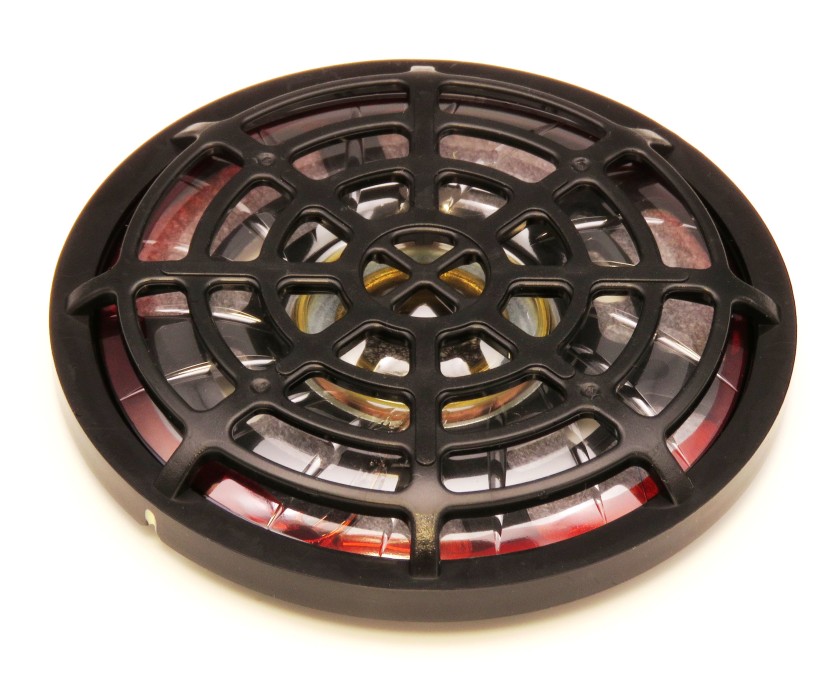
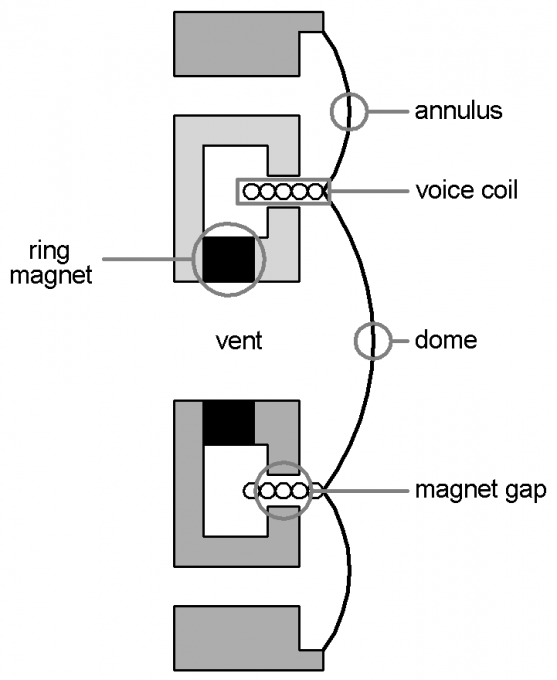
Typical moving coil headphone driver and cross-section
neodymium-iron-boron (abbreviated NdFeB) – a high-strength rare earth magnetic material, often referred to simply as ‘neodymium’, which is almost universally used for the permanent magnets of modern moving-coil and planar magnetic headphone drive units
occlusion effect – the effect whereby a person perceives their voice as boomy if the entrance to the ear canal is partially or fully closed by, for example, wearing a hearing aid or an insert or intra-concha headphone; it is caused by bone conduction becoming dominant when the normal auditory pathway, via the outer and middle ear, is blocked
open-back – a headphone in which sound emitted from the rear of the diaphragm (away from the listener) is free to radiate largely unimpeded; open-back headphones are often considered to provide the best sound quality but have the twin disadvantages of causing potential noise disturbance to people nearby, and of providing the user with little isolation from external sounds

An open-back headphone (Quad ERA-1)
PEEK (abbreviation of polyether ether ketone) – a semicrystalline thermoplastic sometimes chosen in preference to boPET (Mylar) for plastic headphone diaphragms; PEEK has slightly inferior velocity of sound to boPET but a significantly higher melting point (340C versus 250C)
Pentaconn – a 4.4mm TRRRS jack connector, described in JEITA (Japan Electronic and Information Technology Industries Association) Standard RC8141C, which is used as a balanced connector for headphones, particularly where available space precludes the use of a 4-pin XLR; the Pentaconn brand name also appears on 2.5, 3.5 and 6.3mm jack connectors, but the term Pentaconn is usually applied to the 4.4mm TRRRS jack (whoever the manufacturer)

Pentaconn jack plug
PET (abbreviation of polyethylene terephlalate) – a polyester material which in biaxially-oriented form (boPET, often known by its DuPont trade name Mylar) is commonly used for headphone diaphragms
pinna (plural pinnae) – anatomical name for the external ear flap
planar magnetic (abbreviated PM) – a form of electromagnetic drive unit in which the diaphragm and its ‘voice coil’ are planar, known historically as ‘isodynamic’ or ‘orthodynamic’; bar magnets arrayed on one or both sides of the diaphragm, aligned with the voice coil, provide the static magnetic field with which the voice coil’s fluctuating magnetic field interacts to force the diaphragm back and forth normal to its surface; originally introduced in the 1970s, early PM headphones were extremely insensitive due to the low-strength magnetic materials currently available, and never threatened the dominance of moving-coil designs; today, with the readily availability of superior neodymium-iron-boron (NdFeB) magnets, PM headphones achieve much improved sensitivities and have undergone a renaissance
Q (abbreviation of quality factor) – a measure of the severity of a resonance equal to its half-power bandwidth divided by its centre frequency; low-Q resonances result in broad response peaks and are excited by a wide range of adjacent frequencies but release stored energy quickly; high-Q resonances result in narrow response peaks and are excited by a narrow band of frequencies but release stored energy slowly; the 60dB decay time of a resonance is given by 2.2 Q/fc where fc is the resonance centre frequency
quarter-inch jack – the 6.3mm-diameter jack connector original developed for telephone exchange earphones which was adopted and adapted for use with headphones developed for music reproduction; originally a TS (tip and sleeve) jack, it had a ring connector added (TRS) to convey unbalanced stereo signals with a common earth; the connection convention for a stereo jack is left channel to tip, right channel to ring, and earth to sleeve; see the ‘TRS’ entry for a diagram
resonance – increased amplitude of vibration in a mechanical or electrical system at frequencies close to natural frequencies of the structure or circuit; resonances store and later release energy, and this time domain ‘blurring’ can determine their audibility more than their effect on frequency response
SBC (abbreviation of Sub-Band Codec) – a low-complexity audio codec mandated by the Bluetooth interface standard; most Bluetooth headphones improve on SBC’s sound quality by also offering compatibility with superior codecs such as the aptX family, LDAC and LHDC
semi-open-back – a headphone in which sound radiated from the rear of the diaphragm is neither contained (as in a closed-back headphone) nor free to radiate into the room unimpeded (as in an open-back headphone); instead an acoustical resistance, typically in the form of a fine mesh, is placed behind the diaphragm, with the result that the semi-open-back headphone provides greater isolation of external sound than an open-back headphone, and radiates less sound too, without being as effective in either respect as a closed-back design
sensitivity – the sound pressure level generated by a headphone or loudspeaker for a stated electrical input; with headphones the input level is usually either 1 volt rms or 1 milliwatt (1mW); conversion between the two requires knowledge of the headphone’s impedance
SPL (abbreviation of sound pressure level) – a standardised scale of sound pressure expressed in decibels where the (often unstated) reference pressure is 20µPa, which is approximately the threshold of normal human hearing at those frequencies where the ear is most sensitive (around 2 to 5kHz); average SPL for domestic music replay is typically 75dB but short-term peaks on high dynamic range programme may be 30dB or more higher than this, while live music can generate peaks in excess of 110dB; protracted periods of listening at high SPL can result in permanent hearing loss
supra-aural – a form of over-head headphone in which the earpads rest on, and sometimes seal to, the ear rather than surrounding it as in a circumaural headphone; the principal attraction of supra-aural headphones is that their capsules can be significantly smaller, forming a more compact package for portable use
titanium – a metallic element with density about 58% that of steel which has a speed of sound similar to aluminium and magnesium, as a result of which it has been widely used as a loudspeaker diaphragm material; while titanium is commonly chosen for tweeter and horn compression diaphragms, it is rarely used for headphone diaphragms, more often being applied as a thin surface coating to plastic diaphragms to increase their stiffness, and thus improve their resonance behaviour; where titanium is used for diaphragms, it has been reported that tensile modulus can be improved by boronising or diamond coating it
TRS – the simplest form of stereo jack connector in which the plug has three contact areas: tip (left channel), ring (right channel) and sleeve (common earth)

TRS mini-jack plug
TRRS – a form of jack connector in which the plug has four contact areas: tip, ring 1, ring 2 and sleeve

TRRS mini-jack plug
TRRRS – a form of jack connector in which the plug has five contact areas: tip, ring 1, ring 2, ring 3 and sleeve (see the ‘Pentaconn’ entry for a diagram)
TWS (abbreviation of true wireless stereo) – a type of insert or intra-concha headphone in which there is no wired connection either to the signal source or between the left and right elements of the headphone; TWS headphones score for convenience but have downsides: the wireless interface may not match the sound quality of a wired connection, and the earpieces are inherently easy to lose
tympanum – the anatomical name for the eardrum
unbalanced – a two-conductor signal interface in which one conductor carries signal voltage and the other is connected to earth (ground); unbalanced connection is simple and inexpensive but provides less robust immunity to external interference than the balanced alternative; conventionally headphones have used unbalanced connection but in recent years balanced connection has been offered as an alternative by some headphone amplifiers, for compatible headphones
voice coil – a length of insulated wire, wound into a cylinder, typically on a tubular former, through which signal current is passed in a moving coil drive unit; interaction of the fluctuating electromagnetic field set up around the voice coil interacts with the fixed magnetic field generated by (usually) a permanent magnet nearby to generate a force on the voice coil which varies according to signal current; this force in turn vibrates a diaphragm to which the voice coil is attached, generating sound
waterfall – the colloquial name for a quasi-three-dimensional graph particularly associated with the display of cumulative spectral decay data, so called because it resembles a waterfall
A cumulative spectral decay waterfall displaying
ridges indicative of diaphragm resonances
XLR – a family of robust audio connectors widely used for making balanced interconnections in professional audio, and in some domestic audio products too
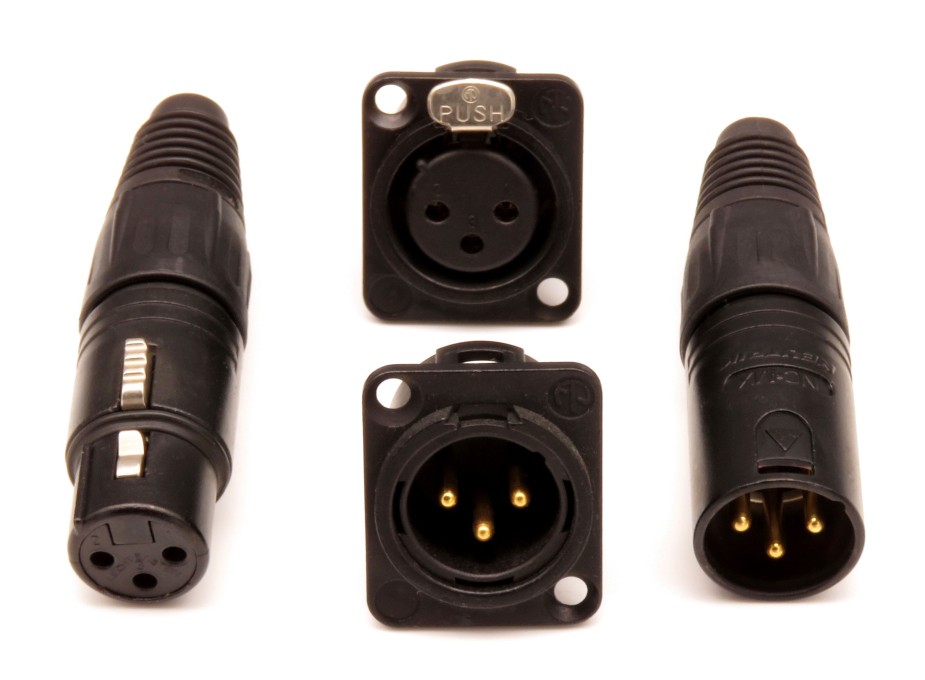
Cable-mount and chassis-mount three-pin XLR connectors, male and female
Y-cable – a headphone connecting cable which splits at a point along its length in order to feed each capsule separately
yoke – in traditionally constructed headphones, the means of articulating a headphone capsule so that it can rotate both horizontally and vertically to fit against the listener’s head